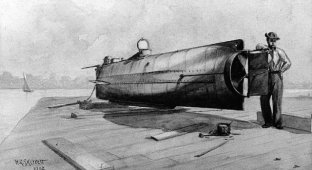The construction of Project 941 Akula submarine cruisers (according to the international classification "Typhoon") was a kind of response to the construction in the United States of Ohio-class nuclear missile submarines armed with 24 intercontinental ballistic missiles. In the USSR, the development of a new ship began later than the Americans, so design and construction proceeded almost in parallel.

“The designers were faced with a difficult technical task - to place on board 24 missiles weighing almost 100 tons each,” says S.N. Kovalev, general designer of projects at the Rubin Central Design Bureau for MT. “After many studies, it was decided to place the missiles between two durable hulls There are no analogues to such a solution in the world." “Only Sevmash could build such a boat,” says the head of the Department of the Ministry of Defense A.F. Shlemov. The construction of the ship was carried out in the largest boathouse - workshop 55, which was led by I.L. Kamai. We used a fundamentally new construction technology - the aggregate-modular method, which made it possible to significantly reduce the time frame. Now this method is used in everything, both underwater and surface shipbuilding, but for that time it was a serious technological breakthrough.

As a result, the ship was built in record time - in 5 years. Behind this small number is a huge amount of work by the entire team of the enterprise and its numerous contractors. “The construction of the submarine supported more than a thousand enterprises throughout the country,” recalls A.I. Makarenko, at that time the chief engineer of the Sevmash enterprise. “Our “Shark” was ready a year earlier than the American “Ohio.” Naturally, the government highly appreciated the merits participants in the creation of this unique ship." By order of the Minister of the Shipbuilding Industry, Anatoly Innokentyevich was appointed personally responsible for the construction. For the creation of the nuclear submarine of project 941 A.I. Makarenko and KSP assembler A.T. Maksimov was awarded the title of Hero of Socialist Labor. Responsible deliverer A.S. Belopolsky was awarded the Lenin Prize, N.G. Orlov, V.A. Borodin, L.A. Samoilov, S.V. Pantyushin, A.A. Fishev - State Prize. 1219 employees of the enterprise were awarded orders and medals. Among those who distinguished themselves were shop managers G.A. Pravilov, A.P. Monogarov, A.M. Budnichenko, V.V. Skaloban, V.M. Rozhkov, chief specialists M.I. Shepurev, F.N. Shusharin, A.V. Rynkovich.

In September 1980, an unusually large nuclear submarine, the height of a nine-story building and the length of almost two football fields, touched the water for the first time. Delight, joy, fatigue - the participants in that event experienced different feelings, but everyone was united by one thing - pride in a great common cause. Mooring and sea trials were carried out in record time for a nuclear submarine of such a design. And this is a great merit of the delivery team, such excellent specialists as G.D Pavlyuk, A.Z. Elimelach, A.Z. Raikhlin, and the ship’s personnel under the command of Captain 1st Rank A.V. Olkhovikova. Despite the tight deadlines for the construction and testing of the newest nuclear submarine, situations arose when engineers were required to urgently develop new design solutions. “As you know, the outer hull of the boat is covered with a thick layer of rubber,” continues Anatoly Innokentyevich. “On the Shark, each sheet weighed 100 kilograms, and the total weight of the glued rubber was 800 tons. When the boat first went to sea, part of this the coating came off. We had to quickly invent new gluing techniques.”
The ship adopted the first domestic solid-fuel missile system D-19. The lead cruiser of the series, which later received the name Dmitry Donskoy, carried out a large number of missile launches. “The program for extended testing of missile weapons was more than intense,” recalls the former commander of the BC-5, Captain 1st Rank V.V. Kiseev. “The tests took place not only in the White Sea, but also in the North Pole region. During the missile firing period, no There were technical failures. Everything was very reliable."

After ten years of operation, the world's largest nuclear submarine was raised to the slipway for mid-term repairs. This was a difficult task in terms of ensuring radiation and fire safety, since nuclear submarines had not been repaired at the Sevmash workshops before. After average repairs and replacement of a number of complexes in May 2002, “Dmitry Donskoy” was taken out of the workshop. This date is considered the second birth of the ship. The slipway work and the removal of the ship were supervised by the deputy head of the workshop M.A. Abizhanov, and by the actions of the delivery team on the ship - mechanic G.A. Laptev. “The factory sea trials and state tests of various weapons systems are now successfully undergoing. “Dmitry Donskoy” is unique in its maneuverability and controllability,” says the commander of the nuclear submarine, Captain 1st Rank A.Yu. Romanov, with pride. “This order has amazing combat capabilities. This is the fastest of all the ships in the series, exceeding the previous speed record of Project 941 by two knots. The successful testing of the ship is largely due to the responsible delivery person E.V. Slobodyan, his deputies A.V. Larinsky and V.A. nuclear submarine, specialists in their field, commander of the combat electromechanical unit, captain 2nd rank A.V. Prokopenko, commander of the navigator combat unit, captain-lieutenant V.V. Sankov, commander of the combat communications unit, captain 3rd rank A.R.

A ship, like a person, has its own destiny. This cruiser proudly bears the name of the great Russian warrior, Prince of Moscow and Vladimir Dmitry Donskoy. As the submariners themselves say, their ship is reliable and happy. “Now the fate of this nuclear submarine is clear,” says S.N. Kovalev. “This submarine will for a long time be the most powerful ship of the Navy. Today is a good reason to congratulate all the designers who designed this boat, Sevmash, who it was built by many other enterprises that participated in its creation, and, naturally, the Navy on the anniversary of this wonderful ship.”

“Dmitry Donskoy” has been faithfully serving the Motherland for 25 years. The crew and delivery team change, but the cruiser remains dear to everyone. Today the ship, like a quarter of a century ago, is the first - it is at the forefront of testing new naval missile technology. Happy anniversary and happy sailing to you, "Dmitry Donskoy"!
























